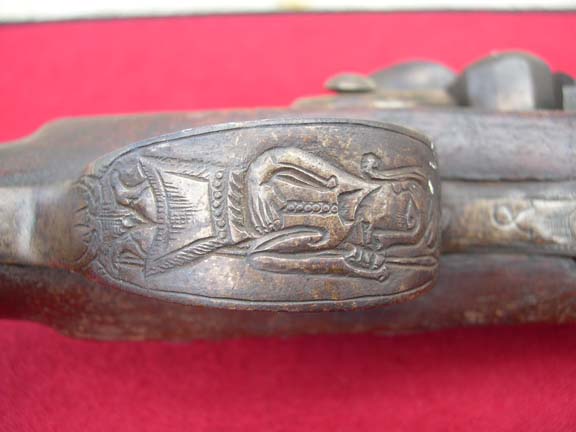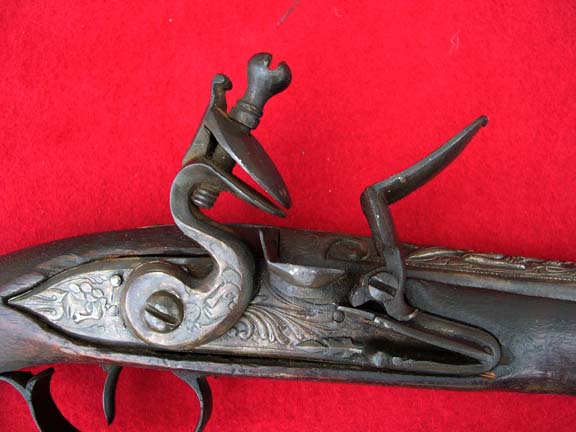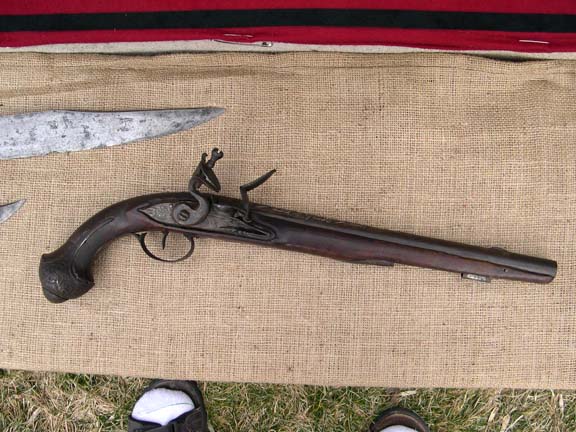| Author |
Message |
|
Eric Ten
Location: Texas Joined: 09 May 2015
Posts: 3
|
 Posted: Sat 09 May, 2015 5:09 pm Post subject: Historical Flintlock - Maybe you folks can help me Posted: Sat 09 May, 2015 5:09 pm Post subject: Historical Flintlock - Maybe you folks can help me |
 |
|
Good evening all,
I joined the forum after attempting to conduct a search on a flintlock that I inherited. The story goes that a friend of the family picked it up in Europe sometime during or after the war. Can anyone point me in a direction that I could try and find more out about the firearm? The gun is just plain cool. I found myself staring at it today for sometime at the amazing craftsmanship. Can't imagine being able to build one of the puppies. Anyway, this is my first post....looking forward to cruising the rest of the forum!
Here some pics I took a few weeks ago and some closer shots from today. Thoughts?








|
|
   |
 |
|
Lin Robinson
|
 Posted: Sun 10 May, 2015 5:48 am Post subject: Posted: Sun 10 May, 2015 5:48 am Post subject: |
 |
|
Hi Eric and welcome to the forum.
Over many years there have been thousands of gun makers producing thousands of different pistols in many countries. Many of these guns are strikingly similar and yet come from very different locations. Others are so unique, for example the Scottish all-metal pistols, as to be instantly recognizable. Unfortunately yours is not in that category.
Absent any makers' marks, at least you do not mention any, proof marks or other identifying markings (and I do not see any in the photos), it is extremely difficult to come up with a location. Lack of provenance is also a problem. Your family member found it in Europe after, I assume, WWII, but that is not much help in determining its origins.
In an attempt to figure out a general area where the pistol might have originated I consulted my copy of Pistols of the World by Claude Blair. This is a very good reference book and fairly well illustrated. I came up empty but again, there were so many different pistols and makers that it is impossible to cover them all in a single reference book.
Here, however, is my opinion, based on your photos. I think what you have may be a Turkish-made "tourist gun." These guns were/are made in Asia Minor and artificially aged in buckets of rocks and dirt then sold to tourists as antiques. I base this, in part, on the heavy, cast-in decoration on the breech area of the barrel and the crude appearance of the flintlock. The wire inlay on the stock, a common method of decoration on high quality pistols, is very crudely done. The pommel cap is crudely cast and the style of decoration, i.e. what it represents, is indecipherable, at least to me. These guns, as is also true of those made in North Africa - which might also be the place of origin - are not usually marked as to maker and since they were never intended to be fired, are not proofed therefore no proof marks are found. The decoration on these guns, like on yours, are really generic, IOW there is no symbolism in the decoration.
I have seen quite a few of these pistols in antique stores and occasionally at gun shows, being offered at antique prices but with no takers.
Sorry to be such a buzz-killer but you can always hang it on your wall and admire it. I just don't think it is a genuine antique pistol from Europe.
Lin Robinson
"The best thing in life is to crush your enemies, see them driven before you and hear the lamentation of their women." Conan the Barbarian, 1982
|
|
  |
 |
|
Eric Ten
Location: Texas Joined: 09 May 2015
Posts: 3
|
 Posted: Sun 10 May, 2015 8:23 am Post subject: Posted: Sun 10 May, 2015 8:23 am Post subject: |
 |
|
Lin
First thank you for taking the time to conduct some research and provide your insight. This is exactly the type of dialog I was looking for. a few things bothered me about this gun. I have not been able to uncover any proof marks which was just odd to me. Some of the screws looked to be replaced while others not as much. They also didnt really look to be handmade ...while other parts were....just wasn't adding up. Also although the gun is obviously old the hammer and trigger work smoothly. The thing has almost a hair trigger. That was surprising given how aged it is.
I have a lot of late 1800/early 1900 firearms and have collected for sometime.....just never got into the flintlock style. I've run into artificial aging before and I'm not ruling your hypothesis out....as it does make sense and provides a highly possible answer to some of the questions I had. The wood does look old though and the patina is natural (at least some of it). If this is a tourist gun it's been around for awhile.
Again, thanks for your time. I'll have to check out the book you referenced as well. I'm enjoying cruising the forum!
Eric
|
|
   |
 |
|
Gregory J. Liebau
Location: Dinuba, CA Joined: 27 Nov 2004
Posts: 669
|
 Posted: Sun 10 May, 2015 8:50 am Post subject: Posted: Sun 10 May, 2015 8:50 am Post subject: |
 |
|
Hello Eric,
Welcome to the forum and thanks for the interesting inquiry. As the son of a nineteenth century gun collector, I've been around my fair share of pistols - many similar to this, but mostly American made examples. At first the apparent decorations on weapons like these can be dazzling, but as Lin pointed out, a number of details were poorly executed. European and American craftsmen also had a tendency to be subtle when decorating their guns, exaggerating perhaps one or two aspects of the weapon, but leaving the rest quite simple. Only the finest weapons were made with such extreme amounts of detail as we see in your gun, and if that was done it was done so with skill and care - which is clearly lacking in this case.
That said, I think that Lin's assessment of it being a weapon made somewhere in the Near East or Northern Africa is probably correct. Cheers!
-Gregory
|
|
  |
 |
|
Lin Robinson
|
 Posted: Sun 10 May, 2015 10:47 am Post subject: Posted: Sun 10 May, 2015 10:47 am Post subject: |
 |
|
Here are some photos of a pistol that I put in my files when it came up. It is a Turkish-made "tourist" pistol. I do not remember when I got these and they may have come form this forum but I kind of doubt it. Any way, you can see that the pistol's overall architecture is pretty good but the execution by the maker is not. At one time I had detailed photos of the cast-in decoration on the breech of the barrel which was heavy and crude like that on Eric's pistol. The decoration of the trigger guard is something like that on the breech and appears to be a man wearing a caftan.
Eric's comments on the smooth action of the lock also indicate to me that it is not very old. Removing the lock and looking at the inner workings might shed some light on things. If the interior is covered with file marks yet not rusted then that would indicate recent construction. I will be willing to bet there are no markings on it. However, since this, although unlikely, could be an antique, I do not recommend removing the lock unless you are quite certain of how to do it without damaging the wood around it.
Any way, thanks for sending the photos and the information.
 Attachment: 31.58 KB Attachment: 31.58 KB

 Attachment: 41.1 KB Attachment: 41.1 KB

 Attachment: 68.19 KB Attachment: 68.19 KB

Lin Robinson
"The best thing in life is to crush your enemies, see them driven before you and hear the lamentation of their women." Conan the Barbarian, 1982
|
|
  |
 |
|
Eric Ten
Location: Texas Joined: 09 May 2015
Posts: 3
|
 Posted: Mon 11 May, 2015 5:50 am Post subject: Posted: Mon 11 May, 2015 5:50 am Post subject: |
 |
|
Lots of great information and insight here! Yesterday afternoon I inspected the gun again....I can definitely see many of the points. Also dry fired the gun a few times and that mech is indeed way too smooth given the amount of aging. So it sounds like this could be an older turkish tourist gun that was picked up from someone/somehow during the war. How long have these guns been produced in that area?
Lin, the pictures you posted look very similar concerning the build to the gun I have....Such an interesting world when it comes to antique guns!
Eric
|
|
   |
 |
|
Lin Robinson
|
 Posted: Mon 11 May, 2015 12:13 pm Post subject: Posted: Mon 11 May, 2015 12:13 pm Post subject: |
 |
|
I don't think anyone knows exactly when or where the trade in these guns began. My guess would be the late 19th c. but they may have been around even earlier. Any time a "tourist" arrives any where, somebody is going sell them a "valuable antique" item from the region. It is just human nature.
As far as the lock goes, real antique locks have real antique springs. They may be in fine condition but most of them are not and the grit that builds up in them over many years usually makes the action rough rather than smooth. I have a 200 year old French musket lock which flew apart the first time I tried to cock it. I once had my hands on what I thought was an antique European pistol until I took off the lock and found a rough filed internal lock plate with parts that were rough as well. The pistol actually cocked smoothly but the visual inspection by me and some people who really knew what they were looking at convinced me that it was a late reproduction.
Any way, enjoy the pistol for what it is.
Lin Robinson
"The best thing in life is to crush your enemies, see them driven before you and hear the lamentation of their women." Conan the Barbarian, 1982
|
|
  |
 |
|
|
You cannot post new topics in this forum
You cannot reply to topics in this forum
You cannot edit your posts in this forum
You cannot delete your posts in this forum
You cannot vote in polls in this forum
You cannot attach files in this forum
You can download files in this forum
|
All contents © Copyright 2003-2025 myArmoury.com — All rights reserved
Discussion forums powered by phpBB © The phpBB Group
Switch to the Basic Low-bandwidth Version of the forum
|

